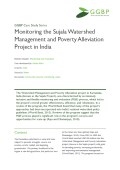This paper aims to value the biodiversity functions of India’s natural ecosystems and suggests a method to adjust national (GDP) and state income (GSDP) accounts accordingly. The main objectives of this study are to: (1) identify appropriate indicators to assess the state of biodiversity in different states in India based on the available data from secondary sources, (2) estimate the value of biodiversity in Indian forest ecosystems, and (3) estimate the value of the depletion of biodiversity due to forest losses in different Indian states. The paper discusses the biodiversity profile in India and the ways to estimate the value of biodiversity in India. It also includes policy implications of the findings.
Recognizing that GDP growth is too narrow and inappropriate as a measure of economic growth and national wealth, the paper proposes to build a framework of adjusted national accounts that represents genuine net additions to national wealth, which is referred to as "Green Accounts." This system of environmentally-adjusted national income accounts will not only reflect the depletion of natural resources and the health costs of pollution in economic terms, but it will also reward additions to the stock of human capital through education. This paper is the fourth in a series of monographs of the Green Accounting for Indian States and Union Territories Project (GAISP), which aims to set up top-down economic models for state-wide annual estimates of adjusted GSDP, thus capturing and analysing true value addition at both state and national levels.

